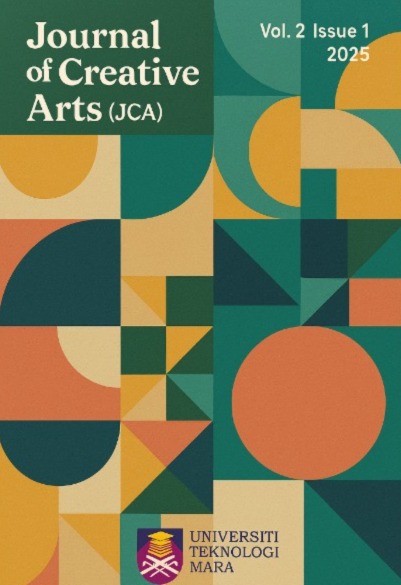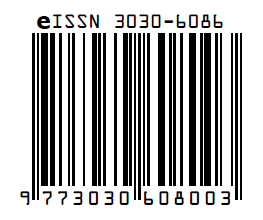Threads of Identity, The Cultural Tapestry of the Jawi Peranakan Kebaya
DOI:
https://doi.org/10.24191/jca.v2i1.4210Keywords:
Jawi Peranakan, kebaya, cultural identity, hybridity, intercultural interaction, Islamic modesty, Malay aestheticsAbstract
The Jawi Peranakan community stands as a remarkable testament to the rich tapestry of cultural exchange and hybrid identity in Southeast Asia. Emerging from the intermarriages between Tamil Muslim traders, known as Chulias, and local Malay women during the 17th and 18th centuries, this unique group has woven together diverse influences from Indian, Malay, and Islamic traditions. Central to their cultural expression is the kebaya, a traditional garment that transcends mere fashion to embody the community's historical journey, social status, and religious values. The kebaya, originally a long, flowing blouse worn over a sarong, has undergone significant evolution, reflecting the intricate interplay of cultural influences that define the Jawi Peranakan identity. As the Chulias integrated into local societies, they adapted their attire to align with Islamic principles of modesty while incorporating elements of Malay aesthetics and Indian textile artistry. This garment not only serves as a symbol of cultural heritage but also as a marker of social standing, showcasing the wealth and refinement of the Jawi Peranakan women who wear it.Moreover, the kebaya's design and construction reveal a fascinating narrative of resilience and adaptation. The incorporation of vibrant colors, intricate patterns, and luxurious fabrics speaks to the community's ability to navigate and negotiate their hybrid status within the broader Malaysian landscape. The use of traditional accessories, such as the kerongsang, further emphasizes the cultural synthesis that characterizes the Jawi Peranakan identity. This essay delves into the evolution of the Jawi Peranakan kebaya, exploring its intricate designs, the cultural synthesis it represents, and its enduring significance in preserving the heritage of a community that continues to navigate the complexities of identity in a modern world. Through the lens of the kebaya, we can appreciate the profound impact of intercultural interactions and the resilience of the Jawi Peranakan in maintaining their unique cultural legacy amidst the broader Malaysian landscape. By examining the historical context and contemporary relevance of the kebaya, we gain insight into the broader themes of cultural integration, identity formation, and the enduring power of tradition in shaping the lives of the Jawi Peranakan community
References
Ahmad, H. (2022). A content analysis of Malay clothing in Malaysia. International Virtual Colloquium on Multi-disciplinary Research Impact (2nd Series). Shah Alam: Universiti Teknologi MARA.
Aljunied, S. M. (2009). Colonialism, violence and Muslims in Southeast Asia: The Maria Hertogh controversy and its aftermath. Routledge.
Arasaratnam, S. (1996). The Chulia Muslim merchants in Southeast Asia, 1650–1800. In S. Subrahmanyam (Ed.), Merchant networks in the early modern world, 1450–1800 (pp. 159– 178). Hampshire: Ashgate Publishing.
Barnard, T. P. (2014). Abdullah bin Abdul Kadir Munshi: Hikayat Abdullah and the making of modern Malay selfhood. Journal of Southeast Asian Studies, 45(2), 171-190.
Hassan, H. Z. (2013). Identity and values of Malaysian Muslims among women and their metaphor in fashion. Official Conference Proceedings of The Asian Conference on Arts & Humanities, (pp. 421-431).
Hussin, N. (2016). Trade and society in the Straits of Melaka: Dutch Melaka and English Penang, 1780-1830. NUS Press.
Khoo, J. E. (1996). The Straits Chinese: A cultural history. The Pepin Press.
Khoo, J. E. (2019). Peranakan fashion and identity: The evolution of the kebaya. Asian Fashion Journal, 12(3), 45-67.
MacGregor, A. (2017). European fashion and its influence on Southeast Asian clothing: The Peranakan case. Journal of Global Fashion History, 10(1), 123-139.
Merican, A. M. (2021). Pencorakan Kepulauan Melayu dan Pulau Pinang oleh Kaum Jawi Peranakan dan Hadhrami melalui kewartawanan dan persuratkhabaran sebelum 1942: Satu tafsiran semula. Jurnal Pengajian Media Malaysia, 23(2), 39-52.
Milner, A. (2008). The Malays. Wiley-Blackwell.
Noor, F., & Khoo, E. (2013). Kebaya: Peranakan fashion in an era of globalization.
Peranakan Heritage Press.
Noriah, M. (2016). Hybrid language and identity among the Samsam, Baba Nyonya, and Jawi Peranakan communities in North Peninsular Malaysia. Kemanusiaan, 23(Supp. 1), 1– 23.
Omar, Y. B. (2005). Kaum Jawi Peranakan di Pulau Pinang: Isu-isu budaya dalam konteks pembentukan masyarakat majmuk di Malaysia. Penang: Universiti Sains Malaysia.
Othman, N. (2020). The Peranakan kebaya: A cross-cultural tradition. Malaysian Journal of Textile, 22(1), 91-104.
Reid, A. (2001). Charting the shape of early modern Southeast Asia. Silkworm Books. Roff, W. R. (1970). The origins of Malay nationalism. Yale University Press.
Roff, W. R. (2016). Malay dress and its influence on the Peranakans. Asian Cultural Review, 48(2), 233-245.
Shamsul, A. B. (1996). Nations-of-intent in Malaysia. Asian Studies Review, 20(3), 17-28.
Smith, L. C. (2015). Lace and elegance: The Peranakan kebaya’s European origins. Fashion and Culture Review, 17(4), 195-210.
Teo, P. (2018). Peranakan women and fashion: Shifting identities in the 21st century.
Contemporary Southeast Asia, 40(1), 83-101.
Watson Andaya, B. (1996). A people that range into all the kingdoms of Asia: The Chulia trading network in the Malay world in the seventeenth and eighteenth centuries.
Downloads
Published
How to Cite
Issue
Section
License
Copyright (c) 2025 Asilatul Hanaa Abdullah

This work is licensed under a Creative Commons Attribution-NonCommercial 4.0 International License.




